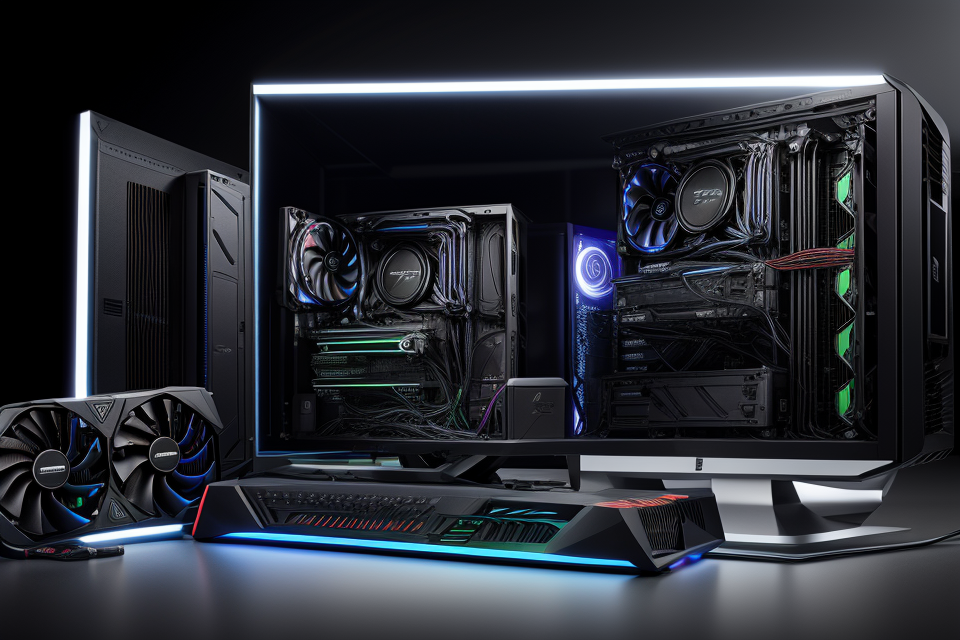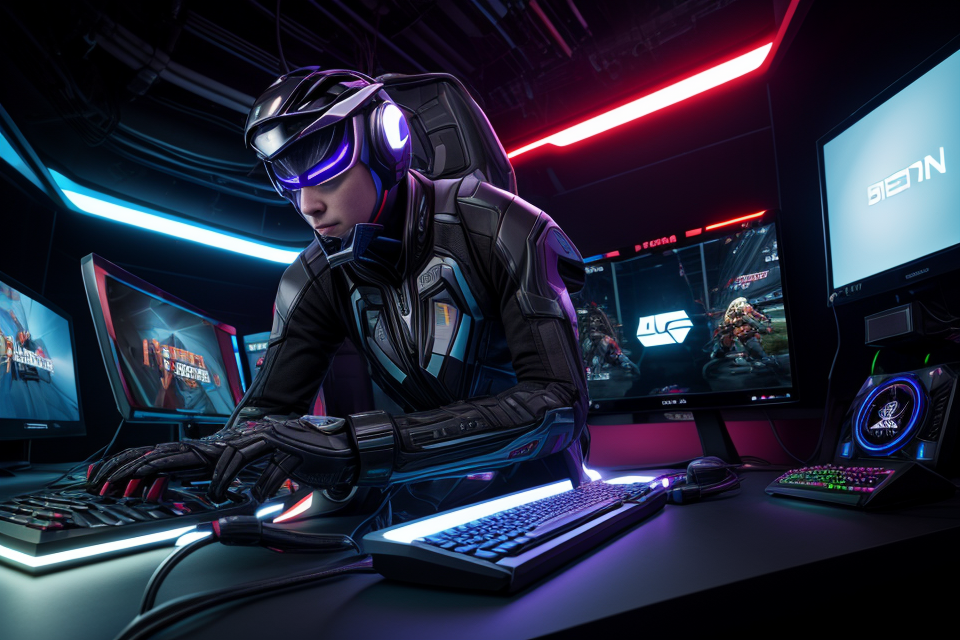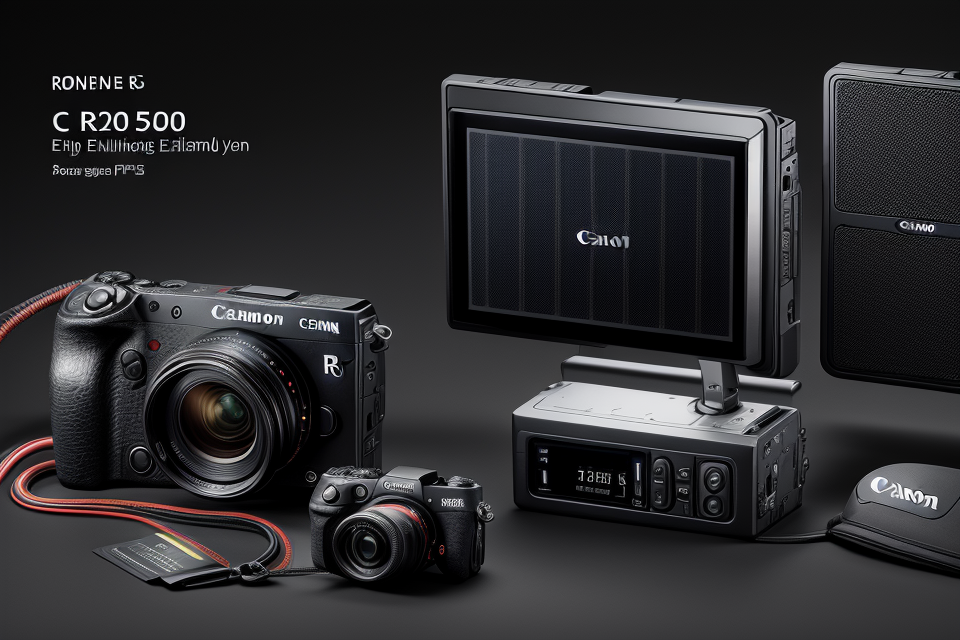
Are you in search of the best budget GPU that will give you the best entry-level graphics performance? Look no further! In this article, we will be discussing the top budget GPUs that will give you the best bang for your buck. With so many options available in the market, it can be difficult to decide which one is the best for your needs. But don’t worry, we’ve got you covered. We will be discussing the features, specifications, and performance of each GPU, so you can make an informed decision. Whether you’re a gamer, a content creator, or just someone who wants to upgrade their graphics, this article is for you. So, let’s dive in and find the best budget GPU for your needs!
As of my knowledge cutoff in September 2021, the best budget GPU for entry-level graphics performance would be the Nvidia GeForce GTX 1660 Super. It offers a great balance of performance and affordability, making it a popular choice for budget-conscious gamers and enthusiasts. With 6GB of GDDR6 memory and 1408 CUDA cores, it provides smooth gaming experiences at 1080p resolution in most modern games. Its power efficiency and compact size also make it a suitable option for small form factor builds. However, it’s important to note that graphics card availability and prices have been unpredictable in recent times due to the global semiconductor shortage, so it’s always a good idea to check for the latest updates and prices before making a purchase.
Factors to Consider When Choosing a Budget GPU
Price
When looking for the best budget GPU for entry-level graphics performance, the price is an essential factor to consider. It is important to strike a balance between cost and performance to ensure that you get the best value for your money. Here are some things to keep in mind when considering the price of a budget GPU:
- Budget Constraints: Determine your budget before purchasing a GPU. It is crucial to set a realistic budget and not overspend on a GPU that may not meet your needs. Consider your other expenses, such as the cost of the CPU, motherboard, and RAM, to ensure that you have enough funds available for the GPU.
- Performance Per Dollar: Consider the performance per dollar ratio when selecting a budget GPU. A GPU that offers the best performance for its price is the ideal choice. Research and compare the performance of different GPUs within your budget to find the one that offers the best value for your money.
- Compatibility: Ensure that the GPU is compatible with your motherboard and power supply unit (PSU). Check the specifications of your motherboard and PSU to ensure that the GPU can fit and run smoothly without any issues.
- Future Upgrades: Consider whether the GPU is future-proof or not. A GPU that can handle the latest games and applications now and in the future is a wise investment. It is better to spend a little more on a GPU that can handle future upgrades than to buy a cheap GPU that will become obsolete in a few years.
In conclusion, when selecting a budget GPU for entry-level graphics performance, it is essential to consider the price, performance per dollar ratio, compatibility, and future upgrades. By considering these factors, you can find the best budget GPU that meets your needs and provides the best value for your money.
Performance
When looking for the best budget GPU for entry-level graphics performance, there are several factors to consider. First and foremost, the performance of the GPU is crucial. This means that you should look for a GPU that can handle the tasks you need it to perform, such as gaming, video editing, or graphic design.
One way to measure the performance of a GPU is by looking at its benchmark scores. The higher the score, the better the performance. However, it’s important to keep in mind that benchmark scores don’t always tell the whole story. You should also consider the specific tasks you’ll be using the GPU for and the software you’ll be running.
Another factor to consider is the power consumption of the GPU. A higher power consumption means that the GPU will require more electricity, which can lead to higher energy bills. On the other hand, a lower power consumption means that the GPU will generate less heat, which can help extend the lifespan of the GPU.
It’s also important to consider the compatibility of the GPU with your current system. Some GPUs may require a specific motherboard or power supply, so it’s important to make sure that your system can support the GPU you’re considering.
Overall, when looking for the best budget GPU for entry-level graphics performance, you should consider the performance, power consumption, compatibility, and price of the GPU. By taking these factors into account, you can find a GPU that meets your needs without breaking the bank.
Compatibility
When looking for the best budget GPU for entry-level graphics performance, compatibility should be one of the key factors to consider. The GPU must be compatible with the computer’s motherboard, power supply unit (PSU), and the case. It is important to check the power requirements of the GPU, as well as the PCIe slot available on the motherboard, to ensure that it will fit and work properly.
Additionally, it is essential to consider the operating system (OS) of the computer. Some GPUs may not be compatible with certain versions of the OS, so it is important to check the manufacturer’s website for compatibility information. It is also recommended to check for any updates or drivers that may be required for the GPU to work properly with the OS.
It is also important to consider the GPU’s cooling system. Some budget GPUs may not have adequate cooling, which can lead to overheating and reduced performance. Therefore, it is essential to check the manufacturer’s specifications for the GPU’s temperature range and noise level, and ensure that the computer’s case has sufficient space for the GPU’s cooling system.
Overall, compatibility is a crucial factor to consider when choosing a budget GPU for entry-level graphics performance. It is important to ensure that the GPU is compatible with the computer’s motherboard, power supply unit, case, and operating system, and has adequate cooling to prevent overheating and reduce noise levels.
Power Consumption
When choosing a budget GPU, it is important to consider power consumption. A GPU with high power consumption may not be suitable for entry-level graphics performance, as it can result in higher electricity bills and may not fit within the budget of a beginner.
Therefore, it is crucial to look for a GPU that offers a balance between performance and power consumption. The lower the power consumption, the better it is for entry-level graphics performance. However, it is important to note that lower power consumption may result in a trade-off in performance. Therefore, it is important to choose a GPU that offers the best balance between performance and power consumption.
Another important factor to consider is the power supply unit (PSU) of the computer. A GPU with high power consumption may require a more powerful PSU to function properly. Therefore, it is important to ensure that the PSU of the computer is capable of handling the power requirements of the GPU.
Additionally, some GPUs may have features such as automatic fan control or power saving modes that can help reduce power consumption. These features can be useful in reducing electricity bills while still maintaining decent graphics performance.
Overall, power consumption is an important factor to consider when choosing a budget GPU for entry-level graphics performance. It is important to choose a GPU that offers a balance between performance and power consumption, while also ensuring that the PSU of the computer is capable of handling the power requirements of the GPU.
Popular Budget GPUs on the Market
Nvidia GeForce GTX 1660 Super
The Nvidia GeForce GTX 1660 Super is a budget graphics processing unit (GPU) that offers impressive performance at an affordable price. It is based on the Turing architecture and features 6GB of GDDR6 memory, making it well-suited for entry-level gaming and basic graphics tasks.
One of the standout features of the GTX 1660 Super is its energy efficiency. It requires minimal power to operate, making it a great choice for those who want to save on electricity costs without sacrificing performance. Additionally, it has a compact design, which makes it easy to fit into most computer cases.
The GTX 1660 Super also offers good frame rates in a range of popular games, including Fortnite, League of Legends, and Minecraft. Its performance is on par with or even slightly better than its main competitor, the AMD Radeon RX 580.
Overall, the Nvidia GeForce GTX 1660 Super is a solid choice for those looking for a budget GPU that can handle basic gaming and graphics tasks. Its combination of affordability, energy efficiency, and performance make it a popular choice among budget-conscious buyers.
AMD Radeon RX 580
The AMD Radeon RX 580 is a popular budget GPU that offers great performance for entry-level gaming and graphics applications. It is based on the Polaris architecture and is a significant improvement over its predecessor, the Radeon RX 480. The RX 580 has 2,304 stream processors, a clock speed of 1,257 MHz, and a memory bandwidth of 256-bit.
One of the main advantages of the RX 580 is its power efficiency. It has a TDP of 150W, which is lower than many other GPUs in its class, making it a good choice for those who want to save on electricity costs. Additionally, the RX 580 is compatible with a wide range of case types, including slim cases, which makes it a great option for those who have limited space in their PC build.
The RX 580 also offers good performance in games and graphics applications. It can handle most modern games at 1080p resolution with high settings, and it can even handle VR applications. It also has support for modern APIs such as DirectX 12 and Vulkan, which allows for better performance and more efficient use of system resources.
In terms of drawbacks, the RX 580 can get quite hot during heavy loads, and its fans can be quite loud. However, these issues can be mitigated by proper cooling and overclocking. Overall, the AMD Radeon RX 580 is a great budget GPU for those who want good performance without breaking the bank.
Nvidia GeForce GTX 1650 Super
The Nvidia GeForce GTX 1650 Super is a budget graphics processing unit (GPU) that is designed for entry-level gaming and basic graphics tasks. It is a more powerful version of the original GTX 1650 and offers improved performance over its predecessor. The GTX 1650 Super is an excellent option for those who are looking for a GPU that can handle modern games at 1080p resolution with high graphics settings.
One of the standout features of the GTX 1650 Super is its power efficiency. It requires minimal power to operate, making it a great choice for those who are building a budget gaming PC or upgrading an older system. The GTX 1650 Super also has a compact design, which makes it easy to fit into any computer case.
In terms of performance, the GTX 1650 Super offers impressive frame rates in modern games such as Fortnite, Rocket League, and Apex Legends. It can also handle more demanding games like Rainbow Six Siege and The Witcher 3 at lower settings. The GTX 1650 Super is also capable of handling basic graphics tasks such as video editing and photo editing.
The GTX 1650 Super is available in a variety of different configurations, including a range of prices and performance levels. It is also compatible with a wide range of motherboards and power supplies, making it a versatile option for those who are building a budget gaming PC.
Overall, the Nvidia GeForce GTX 1650 Super is a great budget GPU for entry-level graphics performance. It offers impressive performance, power efficiency, and a compact design, making it a great choice for those who are looking to upgrade their graphics capabilities without breaking the bank.
Comparison of Budget GPUs: Nvidia GeForce GTX 1660 Super vs AMD Radeon RX 580
Specifications
When it comes to budget graphics cards, the Nvidia GeForce GTX 1660 Super and the AMD Radeon RX 580 are two of the most popular options on the market. Both of these GPUs offer impressive performance at an affordable price point, making them ideal for entry-level gaming and graphics workloads.
Here’s a breakdown of the specifications for each of these budget GPUs:
Nvidia GeForce GTX 1660 Super
- Architecture: Turing
- CUDA Cores: 6GB GDDR6 with 4,752 CUDA cores
- Boost Clock: 1,980 MHz
- Memory: 6GB GDDR6 with 192-bit memory interface
- TDP: 120W
- Power Connectors: 1x PCIe 3.0 x16, 1x PCIe 3.0 x1
AMD Radeon RX 580
- Architecture: Polaris
- Stream Processors: 2,304 stream processors
- Core Clock: 1,257 MHz
- Memory: 8GB GDDR5 with 256-bit memory interface
- TDP: 150W
- Power Connectors: 1x PCIe 3.0 x16, 1x PCIe 3.0 x6
As you can see, both of these budget GPUs offer impressive specifications for their price point. The Nvidia GeForce GTX 1660 Super has more CUDA cores and a higher boost clock speed, while the AMD Radeon RX 580 has more stream processors and a higher core clock speed. Additionally, the AMD Radeon RX 580 has more memory, which can be beneficial for certain graphics workloads.
Overall, both of these budget GPUs offer great value for their price point and can handle a wide range of entry-level graphics workloads. The best option for you will depend on your specific needs and budget, so it’s important to do your research and compare benchmarks before making a decision.
When it comes to entry-level graphics performance, the Nvidia GeForce GTX 1660 Super and the AMD Radeon RX 580 are two of the most popular options in the market. Both of these GPUs are designed to provide excellent performance at an affordable price point, making them ideal for budget-conscious users who want to enjoy smooth graphics performance for gaming, video editing, or other graphics-intensive tasks.
One of the key factors to consider when comparing the performance of these two GPUs is their gaming performance. Both the Nvidia GeForce GTX 1660 Super and the AMD Radeon RX 580 are capable of delivering smooth frame rates at 1080p resolution for most modern games. However, the Nvidia GeForce GTX 1660 Super is generally considered to be slightly faster than the AMD Radeon RX 580, particularly in games that are optimized for Nvidia graphics cards.
Another important factor to consider is the power consumption of these GPUs. The Nvidia GeForce GTX 1660 Super has a TDP (Thermal Design Power) of 120W, while the AMD Radeon RX 580 has a TDP of 215W. This means that the AMD Radeon RX 580 requires more power and generates more heat than the Nvidia GeForce GTX 1660 Super, which may be a concern for users who are building a PC in a small form factor or who are running their system in a tight space.
When it comes to non-gaming tasks such as video editing or 3D modeling, both the Nvidia GeForce GTX 1660 Super and the AMD Radeon RX 580 are capable of delivering good performance. However, the AMD Radeon RX 580 may have a slight advantage in some applications due to its higher memory bandwidth.
In conclusion, both the Nvidia GeForce GTX 1660 Super and the AMD Radeon RX 580 are excellent choices for entry-level graphics performance. However, the Nvidia GeForce GTX 1660 Super may have a slight edge in gaming performance, while the AMD Radeon RX 580 may have a slight advantage in non-gaming tasks. Ultimately, the best choice will depend on the specific needs and preferences of the user.
When it comes to choosing a budget GPU, it’s important to consider not only its performance but also its power consumption. The Nvidia GeForce GTX 1660 Super and the AMD Radeon RX 580 are two popular options in this price range, and they have different power consumption levels.
The Nvidia GeForce GTX 1660 Super has a TDP (Thermal Design Power) of 120W, which means it requires more power than the AMD Radeon RX 580. The AMD Radeon RX 580, on the other hand, has a TDP of 150W, which is higher than the Nvidia GeForce GTX 1660 Super. However, it’s worth noting that the actual power consumption of these GPUs may vary depending on the specific model and the system configuration.
When choosing a budget GPU, it’s important to consider not only its performance but also its power consumption. Both the Nvidia GeForce GTX 1660 Super and the AMD Radeon RX 580 are good options, but they have different power consumption levels. The Nvidia GeForce GTX 1660 Super has a TDP of 120W, while the AMD Radeon RX 580 has a TDP of 150W.
Recommendation
Based on the comparison of the Nvidia GeForce GTX 1660 Super and the AMD Radeon RX 580, the Nvidia GeForce GTX 1660 Super is the recommended budget GPU for entry-level graphics performance. This GPU offers better performance in terms of gaming and graphics rendering compared to the AMD Radeon RX 580, while also consuming less power and producing less heat. Additionally, the Nvidia GeForce GTX 1660 Super has better driver support and a more stable software ecosystem, which makes it a more reliable choice for entry-level graphics work. However, it is important to note that the AMD Radeon RX 580 may still be a good option for those who prioritize AMD’s hardware acceleration capabilities for video editing and other content creation tasks.
FAQs
1. What is a budget GPU?
A budget GPU is a graphics processing unit (GPU) that offers decent graphics performance at an affordable price. It is designed for entry-level gamers, casual users, and small businesses who do not require high-end graphics performance but want to save money on their computer hardware.
2. Why do I need a budget GPU?
If you are an entry-level gamer, casual user, or small business owner, you may not require high-end graphics performance. A budget GPU can still provide you with decent graphics performance for a fraction of the cost of high-end GPUs. It can also help you save money on your overall computer hardware budget.
3. What should I look for in a budget GPU?
When looking for a budget GPU, you should consider the following factors:
* Price: The GPU should be affordable and fit within your budget.
* Performance: The GPU should offer decent graphics performance for your needs.
* Power consumption: The GPU should have low power consumption to help keep your electricity bills low.
* Compatibility: The GPU should be compatible with your motherboard and other components.
* Cooling: The GPU should have adequate cooling to prevent overheating and ensure longevity.
4. Which is the best budget GPU for entry-level graphics performance?
There are several budget GPUs that offer decent graphics performance for entry-level users. Some of the best options include:
* Nvidia GeForce GTX 1660 Super
* AMD Radeon RX 5500 XT
* Nvidia GeForce GTX 1650 Super
* AMD Radeon RX 580
Each of these GPUs offers different levels of performance and price points, so it’s important to research and compare them based on your specific needs and budget.


